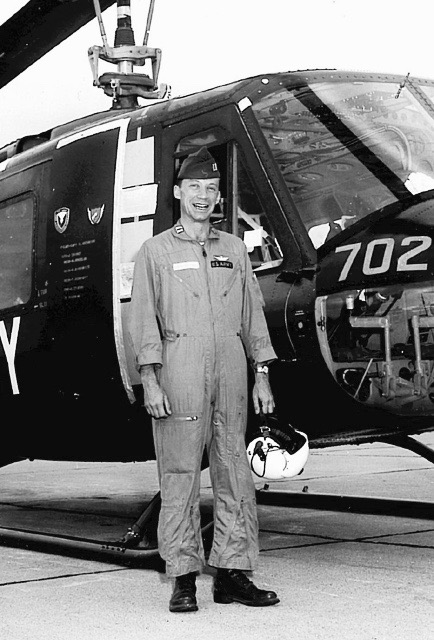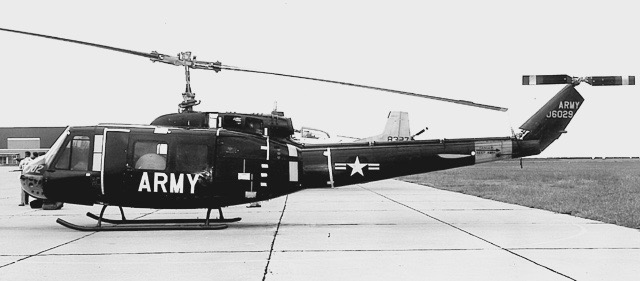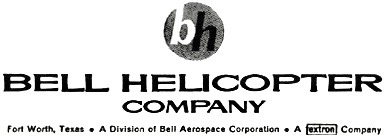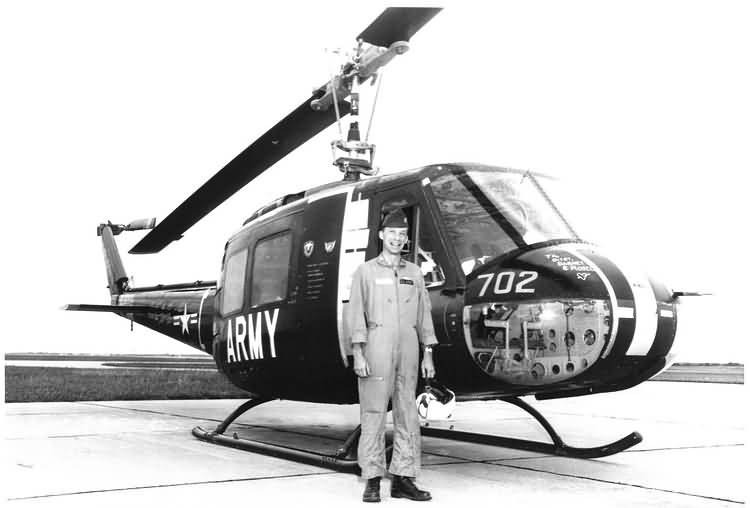
27 September 1964: Captain Michael N. Antoniou flew the number two Bell YUH-1D-BF Iroquois, 60-6029, Bell Helicopter serial number 702, from Edwards Air Force Base in the high desert of southern California, non-stop to Rogers, Arkansas. The distance flown was 2,170.70 kilometers (1,348.81 miles), and established a Fédération Aéronautique Internationale (FAI) World Record for Distance Without Landing.¹
Captain Antoniou was a project test pilot assigned to the U.S. Army Aviation Test Activity at Edwards.
60-6029 was modified by Bell to reduce aerodynamic drag and weight. The windshield wipers, door handles, main rotor stabilizer bar and associated dampers, tail rotor drive shaft cover and 42° gear box cover had been removed. Gaps at the doors, crew steps, tail boom cargo compartment, etc., were sealed with tape.

 The Bell Helicopter Co. UH-1D Iroquois (Model 205) was an improved variant the UH-1B (Model 204). The type’s initial military designation was HU-1, and this resulted in the helicopter being universally known as the “Huey.” The UH-1D has a larger passenger cabin, longer tail boom and increased main rotor diameter.
The Bell Helicopter Co. UH-1D Iroquois (Model 205) was an improved variant the UH-1B (Model 204). The type’s initial military designation was HU-1, and this resulted in the helicopter being universally known as the “Huey.” The UH-1D has a larger passenger cabin, longer tail boom and increased main rotor diameter.
The UH-1D was a single main rotor/tail rotor medium helicopter powered by a turboshaft engine. It could be flown by a single pilot, but was commonly flown by two pilots in military service. The helicopter had an overall length of 57 feet, 0.67 inches (17.375 meters) with rotors turning. The fuselage was 41 feet, 5 inches (12.624 meters) long. The helicopter had a height of 13 feet, 7.4 inches (4.150 meters), measured to the top of the mast. The maximum gross weight of the UH-1D was 9,500 pounds (4,309.1 kilograms).
The two blade semi-rigid, under-slung main rotor had a diameter of 48 feet, 3.2 inches (14.712 meters), and turned counter clockwise when viewed from above. (The advancing blade is on the helicopter’s right.) At 100% NR, the main rotor turned 324 r.p.m. The two blade tail rotor assembly had a diameter of 8 feet, 6 inches (2.591 meters). It was on the left side of the pylon in a pusher configuration and turned counter-clockwise as seen from the helicopter’s left. (The advancing blade is above the axis of rotation.)
 The YUH-1D was powered by a Lycoming T53-L-9 or -11 turboshaft engine which was rated at 1,100 shaft horsepower at 6,610 r.p.m., for takeoff (5 minute limit). The T53-L-11 was a two-shaft free turbine with a 6-stage compressor (5 axial-flow stages, 1 centrifugal-flow stage) and a 2-stage axial-flow turbine (1 high-pressure stage, and 1 low-pressure power turbine stage). As installed in the UH-1, the engine produced 115 pounds of jet thrust (511.55 Newtons) at Military Power.
The YUH-1D was powered by a Lycoming T53-L-9 or -11 turboshaft engine which was rated at 1,100 shaft horsepower at 6,610 r.p.m., for takeoff (5 minute limit). The T53-L-11 was a two-shaft free turbine with a 6-stage compressor (5 axial-flow stages, 1 centrifugal-flow stage) and a 2-stage axial-flow turbine (1 high-pressure stage, and 1 low-pressure power turbine stage). As installed in the UH-1, the engine produced 115 pounds of jet thrust (511.55 Newtons) at Military Power.
Its maximum speed, VNE, was 124 knots (143 miles per hour, 230 kilometers per hour). With full fuel, 206.5 gallons (781.7 liters), the helicopter had a maximum endurance of three hours.
60-6029 was later modified to the prototype YUH-1H.

¹ FAI Record File Number 2180
© 2018, Bryan R. Swopes
Without the sta-bars, was it harder to hover? Did they use Aux tanks?
Thanks!
John, hovering wouldn’t have been a problem. Arthur M. Young designed the stabilizer bar for the original Bell Model 30, which was then adopted for the Models 47, 204, 205 and 209. When I transitioned from the Bell 47 to the 206 JetRanger at Bell’s Forth Worth pilot school, sometime in the last half of the 20th Century, I asked about that. The instructors explained that, “A pilot can learn to fly anything.” Yes, the 206 was more sensitive—and responsive—in a hover than a 47, but, yeah. I learned without much difficulty. The UH-1C and AH-1G both use the 540 Rotor. The Huey has a stabilizer bar while the Cobra does not. The 212 was the last Bell helicopter with a stabilizer bar. The 214, 222, and 230 did not use them. And of course, Bell has now gone over to the Dark Side with its four and five blade main rotor systems. Also, there was an STC to operate the Model 47 without a stabilizer bar.
When the U.S. Army set long-distance records with the OH-6, additional fuel tanks were used, but I have not read anything about auxiliary fuel for THIS record. If I come across anything, I will add the information to the post.
Since they added stability control to the Cobra when the sta-bar was removed you wondered if it was ‘needed’. 1300 miles in a Uh-1 with 1250 lbs of fuel is pretty darn good assuming a 550-600 lb/hr burn rate. Maybe he went up as high as he could go and then just auto’d when the fuel ran out. With 400lbs of rotor blade inertia I’m sure he could have milked quite a bit of distance from that.
I believe this aircraft had extra fuel onboard. Even with additional standard capacity full aux., tanks, the run-out range would be something on the plus side of 650 nm, along with a higher altitude tailwind. You could expect a strong west wind at altitude would be utilized. However, five hundred hundred more nautical miles seems unlikely, but we don’t know the details of the fuel quantity carried. By rough calculation, a lightened Huey could have carried enough fuel for an 11.5-hour flight, which would have made that distance doable with VFR reserves.
Further to my previous comment, I looked at a photo of the aircraft used for the flight and it appeared to have a large non-standard tank installed in the back. That’s not conclusive but it could be a fuel tank?
You are probably correct, Keith. I checked contemporary newspaper articles for further details, but none mentioned additional fuel tanks or fuel capacity.